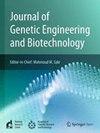Generation of Dual-Color FISH probes targeting 9p21, Xp21, and 17p13.1 loci as diagnostic markers for some genetic disorders and cancer in Egypt
IF 2.8
Q3 Biochemistry, Genetics and Molecular Biology
Journal of Genetic Engineering and Biotechnology
Pub Date : 2024-12-18
DOI:10.1016/j.jgeb.2024.100449
引用次数: 0
Abstract
Introduction
The fluorescence in situ hybridization (FISH) is a very important technique, as it can diagnose many genetic disorders and cancers. Molecular cytogenetic analysis (FISH) can diagnose numerical chromosome aberrations, sex chromosomes anomalies, and many genetic disorders.
Aim
With the limited number of commercially available probes that do not cover all research needs and the high prices of the commercial probes, our goal is to apply recent technologies to produce FISH probes that can accurately and sensitively diagnose genetic diseases and cancer in Egypt and establishing the inhouse production of different FISH probes. We intend to adhere to the published guidelines and validation procedures to ensure the production of accurate FISH probes for clinical diagnosis.
Methods
We used specific DNA segments extracted from BAC clones, and we performed nick translation to label the segment with fluorescence labeled dye. The second method involved the use of specific primers for the centromere of certain chromosomes and using PCR technique for amplification and labeling. The probes were tested on metaphase and interphase cells derived from cultured human peripheral blood samples. We followed standard guidelines to test the adequacy of probe slide hybridization, proper probe localization, probe sensitivity and specificity, probe reproducibility, cut-off values, and overall probe validation.
Results
In this research, we presented the generation of three dual-color probes, each probe has a control locus. We offered three dual-color probes targeted 9p21, Xp21 and 17p13.1 loci. chromosome 9p21probe for diagnosis of structural abnormalities in chromosome 9, the Xp21 to test for structural abnormalities of chromosome X, and the 17p13.1 for TP53 gene to detect the loss of p53. We also produced probes for Down syndrome specific region, Rb gene and centromeres for chromosomes X, 17, and 18.
Conclusion
The produced probes are specific and sensitive and can be produced at the commercial level in the laboratory. The production of FISH probes in Egypt can be used as a powerful diagnostic marker for genetic disorders and cancers and our work can be consider as a base to start national project to produce our needs of FISH probes.
埃及9p21、Xp21和17p13.1位点双色FISH探针的产生作为一些遗传疾病和癌症的诊断标记
荧光原位杂交(FISH)是一项非常重要的技术,因为它可以诊断许多遗传疾病和癌症。分子细胞遗传学分析(FISH)可以诊断数字染色体畸变、性染色体异常和许多遗传疾病。由于市面上可用的探针数量有限,不能满足所有的研究需求,而且商业探针价格高昂,我们的目标是应用最新技术生产FISH探针,能够准确、灵敏地诊断埃及的遗传疾病和癌症,并建立不同FISH探针的内部生产。我们打算遵守已发布的指南和验证程序,以确保生产用于临床诊断的准确FISH探针。方法利用从BAC克隆中提取的特定DNA片段,用荧光标记染料标记刻痕翻译。第二种方法涉及使用特定的引物对某些染色体的着丝粒和使用PCR技术进行扩增和标记。这些探针在培养的人外周血样本的中期和间期细胞上进行了测试。我们遵循标准指南来测试探针玻片杂交的充分性、探针的适当定位、探针的敏感性和特异性、探针的可重复性、截止值和探针的整体有效性。结果在本研究中,我们提出了三种双色探针的生成,每个探针都有一个控制位点。我们提供了针对9p21、Xp21和17p13.1位点的三种双色探针。染色体9p21探针用于诊断9号染色体的结构异常,Xp21探针用于检测X染色体的结构异常,17p13.1探针用于检测TP53基因的缺失。我们还为X、17和18号染色体生产了唐氏综合症特定区域、Rb基因和着丝粒探针。结论所制探针特异性强,灵敏度高,可在实验室批量生产。埃及FISH探针的生产可以作为遗传疾病和癌症的有力诊断标记,我们的工作可以作为启动国家项目的基础,以生产我们需要的FISH探针。
本文章由计算机程序翻译,如有差异,请以英文原文为准。
求助全文
约1分钟内获得全文
求助全文
来源期刊

Journal of Genetic Engineering and Biotechnology
Biochemistry, Genetics and Molecular Biology-Biotechnology
CiteScore
5.70
自引率
5.70%
发文量
159
审稿时长
16 weeks
期刊介绍:
Journal of genetic engineering and biotechnology is devoted to rapid publication of full-length research papers that leads to significant contribution in advancing knowledge in genetic engineering and biotechnology and provide novel perspectives in this research area. JGEB includes all major themes related to genetic engineering and recombinant DNA. The area of interest of JGEB includes but not restricted to: •Plant genetics •Animal genetics •Bacterial enzymes •Agricultural Biotechnology, •Biochemistry, •Biophysics, •Bioinformatics, •Environmental Biotechnology, •Industrial Biotechnology, •Microbial biotechnology, •Medical Biotechnology, •Bioenergy, Biosafety, •Biosecurity, •Bioethics, •GMOS, •Genomic, •Proteomic JGEB accepts
 求助内容:
求助内容: 应助结果提醒方式:
应助结果提醒方式:


